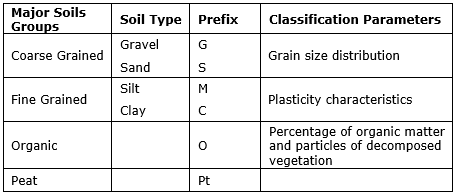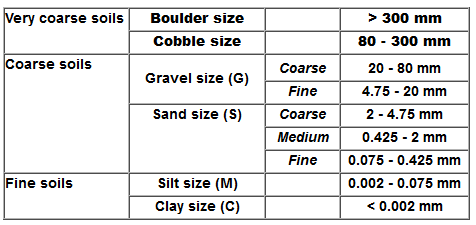Classification of Soils | Civil Engineering SSC JE (Technical) - Civil Engineering (CE) PDF Download
Chapter 2
Classification of Soils
SOIL CLASSIFICATION
Soils are classified according to the following important systems:
USCS - (Unified soil clasification system)
ISSCS - (Indian standard soil classification system)
AASHTO - (American association of state highway of transport official)
Textural clasification : Not recommended ‘ISSCS’ is little differ from USCS
USCS OR ISC (Indian soil classification system):
Soils are broadly classified into three divisions:
-Coarse grained soils: In these soils, 50% or more of the total material by weight is larger than 75 micron IS sieve size.
-Fine grained soils: In these soils, 50% or more of the total material by weight is smaller than 75 micron IS sieve size.
Highly organic soils and other miscellaneous soil materials: These soils contain large percentage of fibrous organic matter, such as peat, and the particles of decomposed vegetation. In addition, certain soils containing shells, cinders and other non-soil materials in sufficient quantities are also grouped in this division.
ASSHTO OR HRB:-
Classification of soil is based on both particle size composition and plasticity charateristics.
-According to this system soil are classified into b groups. A-1 to A-7 with an additionl group A-8 for peat or muck.
-This method utilise group index value.
| Group Index value = 0.2a + 0.01bd+ 0.005 ca |
Where,
a = That part of % passing through the 75μ seive, greater than 35% and not exceeding 75,expressed as a positive whole number (Range 1-40)
b = That part of % passing throught 75μ sieve, greater than 15% and less than 55% (Range 1-40)
c = That part of liquid limit greater than 40% and less than 60% (Range 1-20)
d = Plasticity Index greater than 10% and less than 30% (Range 1-20)
-If we put maximum value of a, b, c, d.
Group Index = 0.2 × 40 + 0.01 × 40 × 20 + 0.005 × 20 × 40= 20
GImax=20
-The group index value varies from (0 to 20).
-As the goup index value increases, less desirable a soil for highway construction.
-If the calculated value is -ve from the group index formula, then it is reported as zero
INDIAN STANDARD SOIL CLASSIFICATION SYSTEM:
Soils are divided into three broad divisions:
-Coarse grained soils, when 50% or more of the total material by weight is retained on 75 micro IS sieve.
-For fine grained soils, when more than 50% of the total material passes through 75 micron IS sieve.
-If the soil is highly organic and contains a large percentage of organic matter and particles of decomposed vegetation, it is kept in a separate category marked as peat (Pt).
In all there are 18 groups of soils: 8 groups of coarse grained, 9 groups of fine grained and one of peat.
Prefix and Suffix of ISSCS
| Soil type | Prefix | Subgroup | Suffix |
| Gravel | G | Well graded | W |
| Sand | S | Poorly graded | P |
| Silt | M | Silty | M |
| Clay | C | Clayey | C |
| Organic | O | wL<35% 35%<WL < 50% | L I |
| Peat | Pt | WL > 50% | H |
A-line A-line is a line which represents plasticity index and liquid limit relationship
The 'A' line in this chart is expressed as IP = 0.73 (WL - 20).
Division of soil fractions on the basis of Grain Sizes: 
Gravel, sand, silt, and clay are represented by group symbols G, S, M, and C respectively.
|
2 videos|133 docs|55 tests
|
FAQs on Classification of Soils - Civil Engineering SSC JE (Technical) - Civil Engineering (CE)
| 1. What is the importance of classifying soils in civil engineering? |  |
| 2. How are soils classified in civil engineering? |  |
| 3. What are the different soil properties considered in soil classification? |  |
| 4. How does soil classification impact construction projects? |  |
| 5. Can soil classification change over time? |  |

















